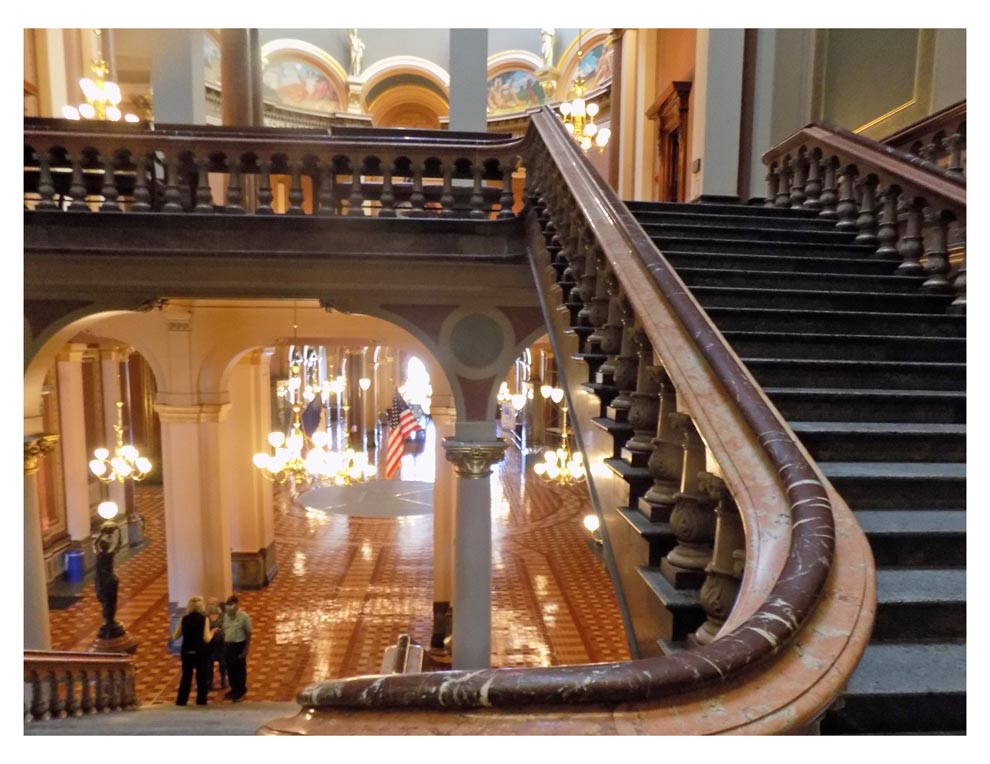

At least 7,000 years ago, based on archeological evidence, humans were present in the Des Moines, Iowa, and Raccoon Rivers area. At least 15 prehistoric American Indian mounds were observed in the by early settlers. City development eventually destroyed all of them.
In May 1843 Captain James Allen supervised the construction of a fort and the U.S. War Department called it Fort Des Moines. The fort was built to control the Sauk and Meskwaki Indians whom the government had moved to the area from their traditional lands in eastern Iowa.
The illegal whiskey trade combined with the destruction of traditional lifeways, led to severe problems for the society. “It is a fact that the location of Fort Des Moines…had corrupted them more and lowered them deeper in the scale of vice and degradation.” Soldiers stationed at Fort Des Moines opened the first coal mines in the area, mining coal from the riverbank for the fort’s blacksmith.
One hour from Des Moines is Johnston, Iowa. first settled in 1846 the same year that Iowa became a state. Camp Dodge has served as a military training location since 1908 and is named after General Grenville Dodge, a Civil War veteran.
It was in 1969 that the city was incorporated. At that time there were 2,236 residents. Before then state law had prevented the formation of a town within three miles of another city. In January 2019 mayor Paula Dierenfeld opened the first City Council meeting of Johnston’s 50th year. There are now 22,000 living in the city.
The main Johnston Public Library opened in limited hours because of the COVID-19. The main library is small and on one floor and set back from the main road. It is sad how little the libraries are to be enjoyed now and with tax dollars still taken without recompense.
In Des Moines the Library system has six branches with the Central Library the biggest. It is in the heart of downtown near the Pappajohn Sculpture Garden. The original library building opened in 1903 on the Riverfront and was designed by architect David Chipperfield. The vision was to have a “library in a park, a park in a library.” It is operating on limited hours and did not open that day until 1 p.m..
The architectural wonder of downtown Des Moines was the State Capitol Building which began construction in 1871 and was completed in 1886. In the west wing of the second floor is the Iowa State Law Library which holds 100,000 law books. I could have read there for hours. The building has 29 types of marble and 12 types of wood. There are 24 fireplaces. The stairways are hand-carved marble and granite. Simply breathtaking!
Libraries in Bettendorf, Cedar Falls, Des Moines, Johnston, Ottumwa, Davenport, Council Bluffs, and Ames now have copies of my “Patsy the Panda” children’s book.
On my route home, with sun blazing on the Iowa cornfields, I decided to stop at the Amana Colonies. I have visited there for decades and it is especially enjoyable in Autumn when grapes are ripening on the vine, when pumpkins and mums are everywhere. It is so pastoral to visit there. The Amana Colonies are a National Historic Landmark. Slow and mellow. Enjoyed lunch at the 80- year-old OxYoke Inn which offers German dishes as well as delicious fried chicken. Desserts are mouth-watering. The restaurant operated at 50% capacity because of COVID-19 and my waitress had worked there for decades.
The Jordan House in Amana is an official site on the National Underground Railroad Network. Today it serves as a museum. Bought a new knife, farmer’s cheese, sugared pecans and cranberry wine for future gifts at the Country Store. The Amana Woolen Mills has the most impressive assortment of blankets, shawls, scarfs.
This tour had been planned for May, but circumstances changed everything this year, didn’t it? Doesn’t matter. All’s well that ends well.

